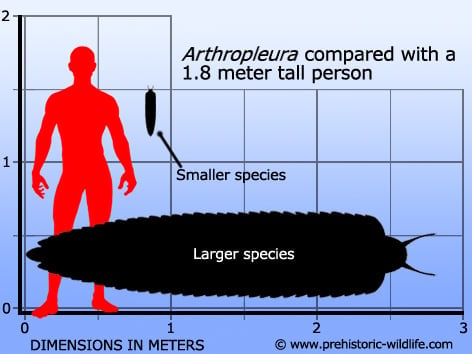In Depth
Arthropleura is a contender for the biggest arthropod of all time, and like with other arthropods of the Carboniferous period, this gigantism has been attributed to the greater abundance of oxygen in the atmosphere of this time. Many fossilised track ways have also been preserved with some even showing Arthropleura moving around trees as it made its way through the Carboniferous forests.
Because the mouth of Arthropleura has never been recovered it is has been difficult to say with certainty if it was a herbivore or carnivore. Instead scientists have had to look at the digestive tract and coprolites of this animal, which have been found to contain spores from plants like ferns, something that is not seen in a carnivorous animal suggesting it was a herbivore.
Arthropleura disappears from the fossil record during the early Permian when the climate dried and the lush forests were replaced with arid and desert like environments. Not only did the oxygen content become reduced from the lack of oxygen producing vegetation, the dry conditions would not have suited Arthropleura because of its crustacean ancestry. Crustaceans as a whole need moist conditions to stop themselves from drying out which is why today you either see them in aquatic environments, or the shaded areas of the ground such as amongst the leaf litter where the ground cannot get dried out by the sun.For another surprisingly large arthropod, check out the eurypterid Jaekelopterus.
Further Reading
– Evidence of pteridophyte–arthropod interactions in the fossil record. – Proceedings of the Royal Society of Edinburgh 86B: 133–140. – A. C. Scott, W. G. Chaloner & S. Paterson – 1985. – The giant Arthropleura trackway Diplichnites cuithensis from the Cutler Group (Upper Pennsylvanian) of New Mexico”. Geological Society of America Abstracts with Programs 36 (5): 66. – Adrian P. Hunt, Spencer G. Lucas, Allan Lerner & Joseph T. Hannibal – 2004. – The largest arthropod in Earth history: insights from newly discovered Arthropleura remains (Serpukhovian Stainmore Formation, Northumberland, England). – Journal of the Geological Society. 179 (3). – Neil Davies et al – 2021.










